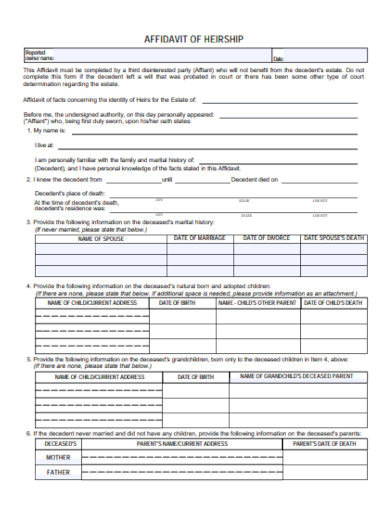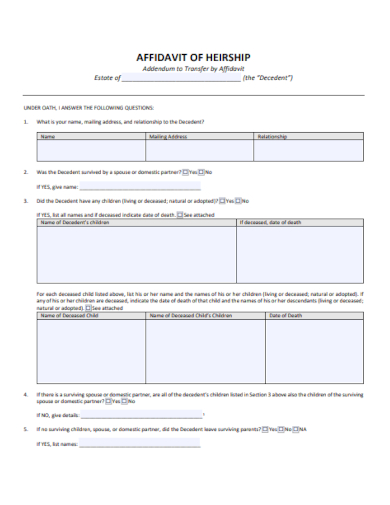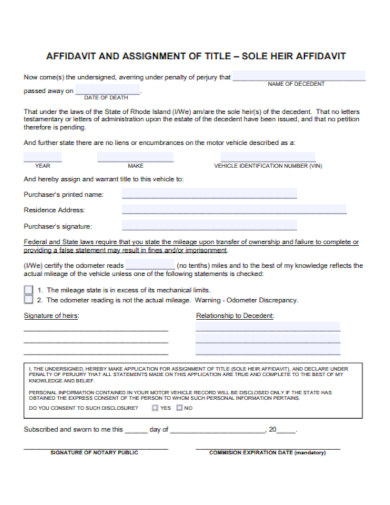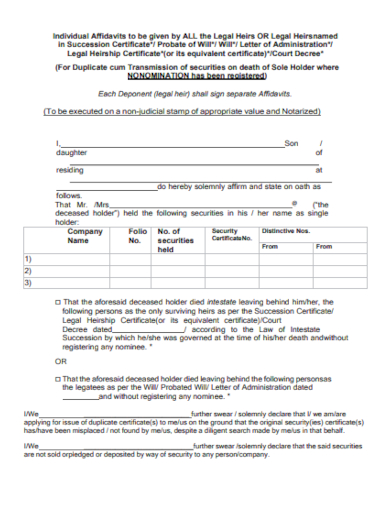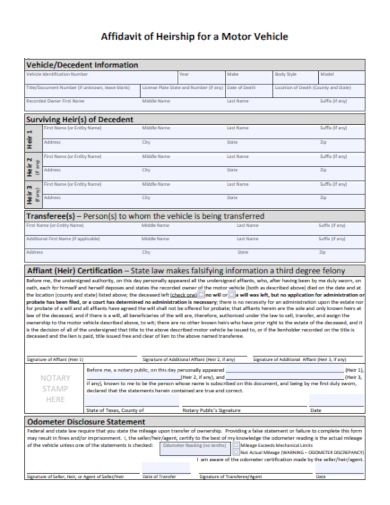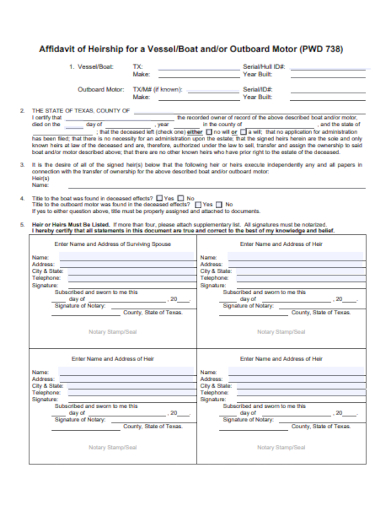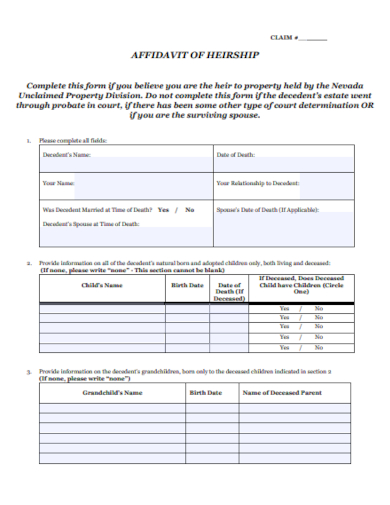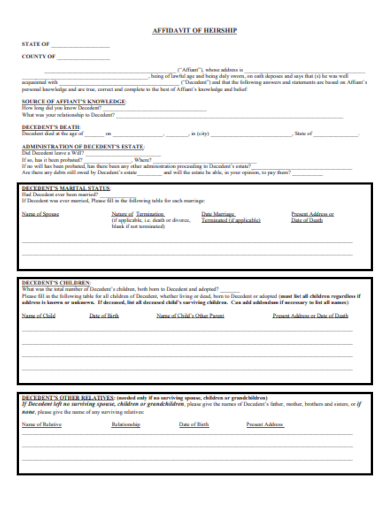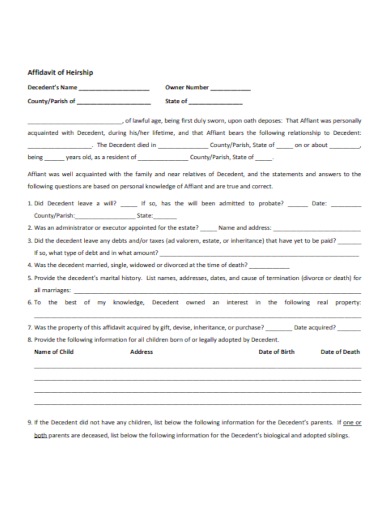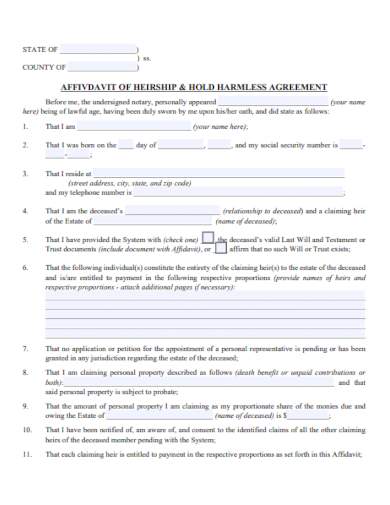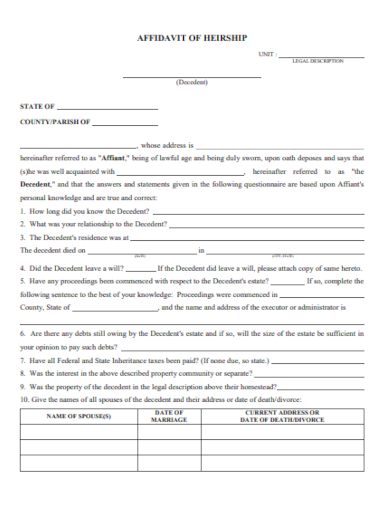The term ‘heir’ refers to an individual who is the surviving family member of a certain person who dies which are generally close family members such as children, grandchildren, or parents. When an individual passes away without a last will and testament, the state intestacy law will determine who will be the heirs and who will inherit the deceased person’s assets. An affidavit of heirship is a legal document that provides information about the heirs of someone who passed away. Other types of affidavits that an individual can use include the affidavit of adverse claim, affidavit of ownership, affidavit of explanation, affidavit of acknowledgment, and affidavit of waiver.
20+ Affidavit of Heirship Samples
1. Affidavit of Heirship Real Estate Template

2. Sample Affidavit of Heirship Template
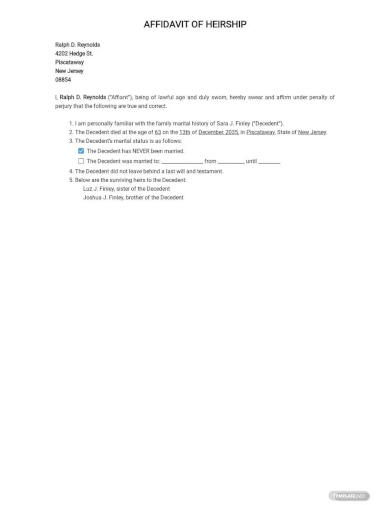
3. Bank Affidavit of Heirship Template

4. Affidavit of Heirship for House Template

5. Affidavit of Heirship Form Template
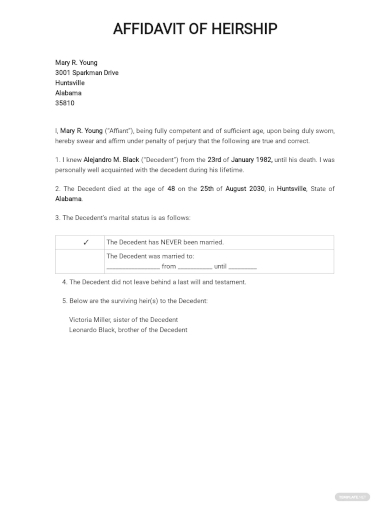
6. Affidavit of Heirship Template
7. Estate Affidavit of Heirship
8. Affidavit of Sole Heirship
9. Affidavit of Legal Heirship
10. Affidavit of Heirship for Motor Vehicle
11. Affidavit of Heirship for Boat
12. Editable Affidavit of Heirship
13. Simple Affidavit of Heirship
14. Affidavit of Heirship Format
15. Decedent Affidavit of Heirship
16. Affidavit of Heirship Agreement
17. Office Affidavit of Heirship
18. Affidavit of Heirship Sample
19. Affidavit of Death and Heirship
20. Affidavit of Beneficiary Heirship
21. Formal Affidavit of Heirship
What is an Affidavit of Heirship?
An affidavit of heirship is a written statement provided by an affiant that includes the name, age, and address of all the relatives of an individual who died. This affidavit letter is created and filed for each probate case to give the court the relevant information about the heirs of the deceased. Heirship refers to the legal right of someone to receive money, possessions, or properties from a close relative who passed away. However, heirship affidavits are used when the person who died has no will but real property, personal property, or small estate.
How to File an Affidavit of Heirship
An heirship affidavit is a necessary document to transfer the properties of a deceased person. This document must be signed and sworn while being witnessed before a notary public by an individual who knew the deceased and their family history which can be a friend of the family or the family’s neighbor. It can be filed with the real property records within the country where the property is located.
Step 1: Provide Information About the Involved Parties
Start by providing the names and addresses of all involved parties. The common terms you can find in this document are the ‘affiant’ which refers to the individual who swears to the facts indicated in the affidavit and the ‘decedent’ which is the person who passed away.
Step 2: Indicate the Appointed Representative
Indicate whether an administrator or a personal representative has been appointed to supervise the decedent’s estate or real property. This also applies to the question of whether or not the decedent has left a will. Once a person is appointed, provide their name and address in the affidavit.
Step 3: Identify the Decedent’s Heirs
You have the option to include information about the decedent’s spouse, children, and other heirs. The friends of the decedent are not usually considered their heirs but if they are named heirs by the decedent, they can try to get the court to accept them.
Step 4: Include a Real Estate and Personal Property Sections
The section for the real estate and personal property of the decedent is utilized to express the intention of using the affidavit to transfer the property to the decedent’s heirs. You can include multiple pieces of real estate properties in an affidavit of heirship as long as they are all in the same county. Otherwise, separate affidavits will be required for each property that is located in a different county.
FAQs
What information must be included in an affidavit of heirship?
An affidavit of heirship must include the name, address, and date of death of the decedent and if they were married, names of their surviving heirs, a statement that tells the decedent has left no will, types of property to be distributed, an agreement by the heirs, and third-party verification of the heir’s right to inheritance.
Who should sign an affidavit of heirship?
Contrary to the common belief, an heirship affidavit is not signed by the heirs but rather by the person who is most familiar with the family history of the decedent and who has nothing to gain from the estate.
What is the purpose of filing an affidavit of heirship?
Affidavits of heirship are filed to help heirs in identifying themselves as the rightful heirs of the decedent, take the property without going through the probate process, have agreed on the distribution process of the estate, and when there is a third party who can verify the rights of the heirs.
When a person dies and leaves behind real properties but without a will, an heirship affidavit can be used to transfer the property to their heirs at law. The requirements for this affidavit vary based on the county the probate court is located. An affidavit of heirship includes information about the affiant and the decedent’s information, marital status, details on their children, other relatives, and real estate and other property. Other types of affidavits that both businesses and individuals can use are the affidavit of identity, affidavit of confirmation, and affidavit of desistance among others.
Related Posts
Sample Meeting Minutes Templates
Presentation Speech Samples & Templates
Ukulele Chord Chart Samples & Templates
Retirement Speech Samples & Templates
Weekly Schedule Samples & Templates
Contractual Agreement Samples & Templates
FREE 9+ Amazing Sample Church Bulletin Templates in PSD | PDF
Sample Business Card Templates
Sample Cashier Job Descriptions
Questionnaire Samples
FREE 10+ Sample HR Resource Templates in PDF
FREE 49+ Sample Job Descriptions in PDF | MS Word
FREE 23+ Sample Event Calendar Templates in PDF | MS Word | Google Docs | Apple Pages
Company Profile Samples
FREE 10+ Leadership Report Samples [ Development, Training, Camp ]

